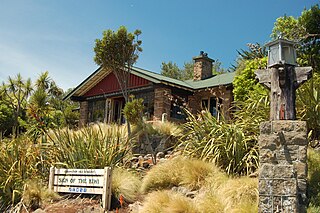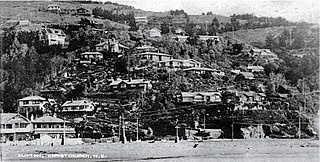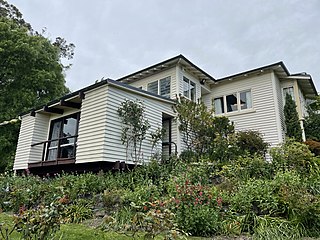
The Canterbury Museum is a museum located in the central city of Christchurch, New Zealand, in the city's Cultural Precinct. The museum was established in 1867 with Julius von Haast – whose collection formed its core – as its first director. The building is registered as a "Historic Place – Category I " by Heritage New Zealand.

Henry George Ell, commonly known as Harry Ell, was a Christchurch City councillor and a New Zealand Member of Parliament. He is famous for his conservation work around Christchurch's Port Hills, his advocacy for the Summit Road, and his construction of the Sign of the Takahe and other road houses along the Summit Road.

Townsend Observatory, owned and administered by the University of Canterbury, was part of the Arts Centre of Christchurch, New Zealand and was open on clear Friday evenings. The building collapsed in the February 2011 Christchurch earthquake.

The Music Centre of Christchurch was a facility for music organisations in the central city of Christchurch, New Zealand. It was established in 1994 and provides office, rehearsal, tuition and performance space for a wide range of music groups. The centre is adjacent to the Cathedral of the Blessed Sacrament and now consists of a group of four heritage buildings formerly the convent of the Sisters of Our Lady of the Missions and Sacred Heart College, a Catholic secondary school for girls founded in 1881 which was amalgamated with Xavier College, a neighbouring Catholic boys' school to form Catholic Cathedral College in 1987.

The Sign of the Kiwi, originally called Toll House, is a small café and shop at Dyers Pass on the road between Christchurch and Governors Bay. It was built in 1916–17 by Harry Ell as a staging post and opened as a tearoom and rest house. It has a Category I heritage classification by Heritage New Zealand and is a popular destination for tourists and locals alike. The building was closed some time after the 22 February 2011 Christchurch earthquake and did not open again until 23 January 2017, six years later. Although located within the burned area, the building was not damaged by the 2017 Port Hills fires a month later.

Our City, more formally Our City O-Tautahi, also known as the Old Municipal Chambers, is a Queen Anne style building on the corner of Worcester Street and Oxford Terrace in the Christchurch Central City. It is a Category I heritage building registered with Heritage New Zealand. From 1887 to 1924 it was used by Christchurch City Council as their civic offices, providing room for meetings of the council and for housing staff, before they moved to the Civic. It was then used for many decades by the Canterbury Chamber of Commerce and served as the main tourist information. It was last used as an exhibition and events centre before being damaged in the Christchurch earthquakes.

Clarendon Tower was a high rise building on Worcester Street at Oxford Terrace in the Christchurch Central City, New Zealand. Built on the site of the former Clarendon Hotel, the façade of the historic building was kept in the redevelopment and was protected by the New Zealand Historic Places Trust as a Category II heritage structure. Following damage from the February 2011 Christchurch earthquake, the 17-storey building has been demolished.

Samuel Hurst Seager was a notable New Zealand builder, draftsman, architect and town planner. He was born in London, England, in 1855, and as a boy emigrated to Christchurch, New Zealand, with his parents in 1870.

Cecil Walter Wood was a New Zealand architect. He was the dominant architect in Canterbury during the interwar period.
Katherine Christian (Kate) Beath was probably the first female architect in New Zealand.

Daresbury, earlier known as Daresbury Rookery is one of the finest grand houses in Christchurch, New Zealand. Designed in the English Domestic Revival style, it is one of the best designs of Samuel Hurst Seager.

St Saviour’s at Holy Trinity is an Anglican church in Lyttelton, Christchurch, New Zealand. St Saviour's Chapel was relocated from West Lyttelton to Christchurch's Cathedral Grammar School in the 1970s. Following the earthquakes and the demolition of Holy Trinity Church, Lyttelton, St Saviour's was returned to Lyttelton to the site of Holy Trinity in 2013.

Clifton is a hillside suburb above Sumner in Christchurch, New Zealand.

The Robert McDougall Art Gallery is a heritage building in Christchurch, New Zealand. It was designed by Edward Armstrong and it opened in 1932. It is a Category I heritage building listed with Heritage New Zealand and is located within the Christchurch Botanic Gardens.

The Christchurch Club is a historic gentlemen's club in the central city of Christchurch, New Zealand. The older of the two Christchurch clubs, it was founded by rural landholders in 1856; the rival organisation, the Canterbury Club, was a breakaway that was founded by urban professionals in 1872.

The Community of the Sacred Name is a convent and chapel in the central city of Christchurch, New Zealand.

Riccarton House is an historic building in Christchurch, New Zealand. It is part of the Riccarton estate, the first area in Christchurch lived in by white settlers, after which the suburb of Riccarton is named. The house was commissioned by Jane Deans, the widow of Canterbury pioneer John Deans, and finished in 1856. It was twice extended; first in 1874, and the work carried out in 1900 more than doubled the size of the house. The Riccarton estate has in stages become the property of Christchurch City Council and Riccarton House itself was sold by the Deans family to the city in 1947. Damaged by the earthquakes in 2010 and 2011, the repaired and renovated building was reopened in June 2014. Riccarton House is used as a restaurant and for functions, and a popular market is held on Saturdays in front of it.

The Railways Department's Housing Scheme was a housing programme which was in-effect between 1922/3 and 1929. The programme saw the construction of over 1,500 prefabricated cottages around the country by the Railways Department. The houses provided accommodation for Railways' workers and their families and occasionally for the general population.
The 1926 King's Birthday Honours in New Zealand, celebrating the official birthday of King George V, were appointments made by the King on the recommendation of the New Zealand government to various orders and honours to reward and highlight good works by New Zealanders. They were announced on 3 July 1926.

Ngaio Marsh House is an historic home in Valley Road in the Christchurch suburb of Cashmere. It was the home of writer Ngaio Marsh for most of her life, and now serves as a museum to her. It is registered as a Category I heritage place by Heritage New Zealand for its outstanding historical significance in relation to Marsh.


















